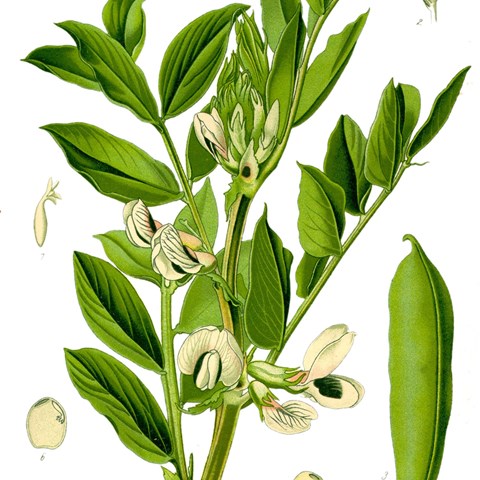Facts:
Financed by SLU Ekoforsk 2011 – 2013
Project leader: Georg Carlsson, SLU.
Project group: Erik Steen Jensen, Kerstin Huss-Danell and Mårten Hetta, SLU; Ann-Charlotte Wallenhammar, HS Konsult AB.

To grow various high-yielding broad bean varieties together can be a way to a safer yield. Intercropping of broad bean and spring wheat can result in a larger proportion of biologically fixed nitrogen being used by the crop and also reduce the risk for weed problems.
Broad bean is a legume that can fix nitrogen biologically, and thus it is an important source of nutrients in organic farming. However, chocolate spot disease and competing weeds may reduce yields significantly and in addition jeopardize the amount of nitrogen that would have been supplied to the crop rotation.
In a research project, it has been tested various strategies to increase crop safety. One way is to intercrop several varieties with different resistance to various types of pathogens or stress, for example, dry conditions. On the one hand the varieties complements each other's qualities and the result can be a diversified resilience that gives large and steady harvests. On the other hand, there is a risk of more variations in the maturity of the beans in variety mixtures, which can provide field beans with patchy quality.
Three varieties of broad beans – Alexia, Gloria and Julia – were included in the trials, each one individually and in two- and three-variety mixtures. Intercropping of broad bean was also combined with and without intercropping with spring wheat. The field trials went on for two seasons at three locations: one at SLU Alnarp, one in Östergötland and one in Västra Götaland. The three sites represent different growing conditions and climate, and are located in regions where the cultivation of broad bean is large or growing.
The researchers documented the harvests, both the green fodder harvest and the combine harvesting, were the grain yield was determined. They also documented the total biomass of weeds. In experiment plots with intercropping with wheat, the yield for both green fodder and grain was determined for broad bean and wheat separately. During July and August, the presence of chocolate spot disease was determined at least four times per season.
There were large differences in yield as well as in the presence of weeds and chocolate spot disease, both between the three sites, and between the two years. In most cases, Alexia and gave Julia a larger harvest than Gloria. Julia was often the least infected by chocolate spot disease. The broad bean varieties in mixtures gave often a small yield increase and slightly less incidence of chocolate spot disease compared to the varieties grown each one separately, although these effects were small compared to the differences between years and location. The combination of Alexia and Julia seem particularly promising, as this mixture resulted in the largest grain yield in five of six times (three places, two years). However, there were no apparent differences in grain yield when the individual varieties were compared with variety mixtures. At Alnarp and Klostergården the nitrogen fixation increased in the intercropping with broad bean and spring wheat, expressed as the percentage of nitrogen fixation part of the total nitrogen content of the broad bean. At these two places, it was with intercropping generally also a smaller amount of weeds compared to when broad bean grown alone. At Länna, the intercropping with spring wheat had no clear effect on weed presence or the nitrogen fixation of the broad bean. In summary, intercropping and variety mixtures are promising strategies for increasing crop safety of broad bean.
The researchers have now gone ahead with the idea that diversified leguminous crops can improve the crop safety. It is being tested in the on-going project LEGATO (Legumes for the Agriculture of Tomorrow; www.legato-fp7.eu), where mixtures of peas are evaluated in field trials at four locations in Europe.
The researchers will also test new combinations of legumes and cereals in organic production in the Swedish project VIOLIN (Focus on Intercropping in Organic Legumes, funded by Formas 2015...2017) Researchers and a group of organic farmers in Skåne decide together what should be grown in field trials at the research station SITES Lönnstorp (SLU Alnarp) and on the participating farmers' farms.
Financed by SLU Ekoforsk 2011 – 2013
Project leader: Georg Carlsson, SLU.
Project group: Erik Steen Jensen, Kerstin Huss-Danell and Mårten Hetta, SLU; Ann-Charlotte Wallenhammar, HS Konsult AB.
E-mail: epok@slu.se